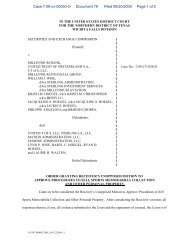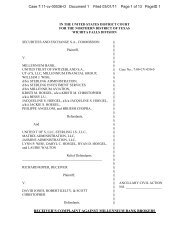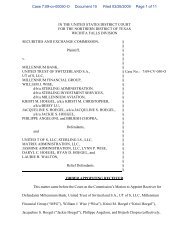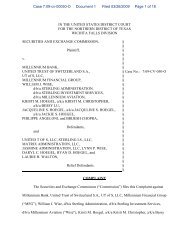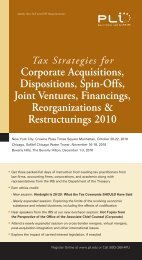View the full text of this document - Martindale.com
View the full text of this document - Martindale.com
View the full text of this document - Martindale.com
You also want an ePaper? Increase the reach of your titles
YUMPU automatically turns print PDFs into web optimized ePapers that Google loves.
REGULATORY RISKS ON THE RISE<br />
The electric utility industry is entering a<br />
period <strong>of</strong> exceptional regulatory risk due<br />
to <strong>the</strong> rising cost <strong>of</strong> producing electricity.<br />
When <strong>the</strong> cost <strong>of</strong> providing electric service<br />
increases, so does <strong>the</strong> risk <strong>of</strong> regulatory<br />
disallowances. The most successful<br />
<strong>com</strong>panies will avoid overreaching, manage<br />
<strong>the</strong> regulatory process well and maintain<br />
positive relationships with <strong>the</strong> regulatory<br />
and political <strong>com</strong>munity.<br />
The cost to produce electricity has already<br />
jumped in <strong>the</strong> last few years as a result<br />
<strong>of</strong> large increases in fossil fuel prices, and<br />
<strong>this</strong> trend is expected to continue. In<br />
addition, <strong>the</strong> industry will need to invest<br />
hundreds <strong>of</strong> billions <strong>of</strong> dollars over <strong>the</strong><br />
next few decades to meet increasing<br />
demand for electricity and replace aging<br />
facilities, and recovery <strong>of</strong> <strong>this</strong> investment<br />
will put enormous additional upward<br />
pressure on electric rates. The industry<br />
must also reduce its reliance on generation<br />
sources that produce greenhouse gas<br />
emissions, such as <strong>the</strong> approximately<br />
50 percent <strong>of</strong> U.S. electric energy that is<br />
currently produced by burning coal.<br />
This will put additional upward pressure<br />
on rates.<br />
Examples <strong>of</strong> regulatory risks include <strong>the</strong><br />
recent stand<strong>of</strong>fs in Maryland and Illinois,<br />
where politicians have intervened to limit<br />
cost recovery in response to substantial<br />
rate increases. The risk <strong>of</strong> disallowances<br />
will not be limited to so-called regulated<br />
services. The same political and regulatory<br />
forces will affect <strong>the</strong> recovery <strong>of</strong> investment<br />
costs by unregulated “merchant” generators<br />
who operate in a mixed regulatory and<br />
<strong>com</strong>petitive environment. For example,<br />
rising prices are already producing<br />
disenchantment with deregulated markets,<br />
and <strong>this</strong> trend is likely to accelerate as<br />
prices continue to rise.<br />
David B. Raskin<br />
Partner<br />
draskin@steptoe.<strong>com</strong><br />
Peer Review Rated<br />
Steptoe & Johnson LLP<br />
STATE UTILITY CONSTRUCTION<br />
INCENTIVES<br />
Evolving state electricity deregulation led<br />
many utilities to acquire power plants<br />
ra<strong>the</strong>r than build new ones. Since 2003-<br />
2004, with <strong>the</strong> effects <strong>of</strong> California’s power<br />
marketing crisis, Enron’s collapse, <strong>the</strong><br />
2003 Nor<strong>the</strong>ast blackout and rising natural<br />
gas prices, however, state deregulation<br />
has slowed. Power demand is growing, but<br />
utilities find it unpr<strong>of</strong>itable to build in<br />
deregulated states. The 50-year lifetime <strong>of</strong><br />
generating plants requires rate assurance for<br />
cost recovery, and several states are seeking<br />
to provide it by creating new regulatory<br />
structures that <strong>com</strong>bine modified <strong>com</strong>petitive<br />
rate review with capacity construction<br />
incentives.<br />
In Virginia, state legislation approved in<br />
2007 ends deregulation and capped rates on<br />
December 31, 2007. The Virginia State<br />
Corporation Commission will set base rates<br />
<strong>of</strong> investor-owned electric utilities under a<br />
modified cost-<strong>of</strong>-service model based on<br />
adjusted return on equity (ROE) <strong>of</strong> a group<br />
<strong>of</strong> Sou<strong>the</strong>astern U.S. utilities. The new<br />
structure authorizes stand-alone rate adjustments<br />
to recover costs <strong>of</strong> new generation<br />
projects, major generating unit modifications<br />
and energy efficiency and conservation<br />
programs. Utilities are granted enhanced<br />
ROE on new capital expenditures as<br />
incentive to build major generation projects.<br />
States that re-regulate with a modified<br />
regulatory scheme that ensures relative<br />
financial certainty will likely receive most<br />
new energy infrastructure development,<br />
while those that stay deregulated or are<br />
slower to regulate may experience less<br />
development. While any investment in <strong>this</strong><br />
area would seem sound, it is important<br />
to understand your market and legislative<br />
and regulatory trends to protect your<br />
shareholders by knowing what equity<br />
returns can be expected.<br />
Joanne Katsantonis<br />
Partner and Chair, Energy and Utilities<br />
jkatsantonis@mcguirewoods.<strong>com</strong><br />
Peer Review Rated<br />
Edward L. Flippen<br />
Partner, Energy and Utilities<br />
eflippen@mcguirewoods.<strong>com</strong><br />
Peer Review Rated<br />
McGuireWoods LLP<br />
THE GOING-PRIVATE<br />
BRIAR PATCH<br />
The power sector is seen as “hungry for<br />
capital,” much <strong>of</strong> which will <strong>com</strong>e from<br />
private equity sources, according to <strong>the</strong><br />
February 20, 2007 edition <strong>of</strong> Platts Electric<br />
Power Daily. An example <strong>of</strong> <strong>this</strong> trend is<br />
<strong>the</strong> proposed buyout <strong>of</strong> TXU Corp., a<br />
publicly traded utility <strong>com</strong>pany regulated<br />
by <strong>the</strong> State <strong>of</strong> Texas, by private equity firm<br />
Kohlberg Kravis Roberts & Co. (KKR).<br />
KKR may have assumed that a relatively<br />
benign regulatory environment in Texas<br />
would prevail. TXU’s assets and operations<br />
are within <strong>the</strong> Electric Reliability Council<br />
<strong>of</strong> Texas (ERCOT), which is within Texas’<br />
geographic boundaries, and largely<br />
outside <strong>the</strong> purview <strong>of</strong> <strong>the</strong> Federal Energy<br />
Regulatory Commission (FERC). This<br />
would mean only <strong>the</strong> regulatory scrutiny <strong>of</strong><br />
<strong>the</strong> Public Utility Commission <strong>of</strong> Texas<br />
(PUCT), whose rules require only notice <strong>of</strong><br />
<strong>the</strong> transaction to PUCT within 30 days<br />
after closing <strong>of</strong> <strong>the</strong> sale. FERC approval<br />
was not necessary.<br />
However, PUCT is working to change its<br />
rules to give it power to review <strong>the</strong><br />
KKR/TXU transaction. Moreover, Electric<br />
Power Daily reported on March 30 that<br />
Rep. Joe Barton, congressman from Texas,<br />
has pressed for FERC regulation <strong>of</strong><br />
ERCOT.<br />
Whe<strong>the</strong>r <strong>the</strong> efforts <strong>of</strong> PUCT, Rep. Barton<br />
or FERC result in control over <strong>the</strong><br />
KKR/TXU transaction is not <strong>the</strong> real story.<br />
The real story is that <strong>the</strong> hard and s<strong>of</strong>t<br />
costs <strong>of</strong> <strong>this</strong> transaction just skyrocketed.<br />
As counsel in such a transaction, plan<br />
ahead, count on opposition, devise a war<br />
plan and count on exponential increases in<br />
transaction costs. Whe<strong>the</strong>r <strong>the</strong> costs are<br />
worth it will remain to be seen.<br />
Douglas F. Pedigo<br />
Partner, Corporate and Securities<br />
doug.pedigo@tklaw.<strong>com</strong><br />
Peer Review Rated<br />
Thompson & Knight LLP<br />
(Continued on next page)<br />
JULY 2007<br />
19



